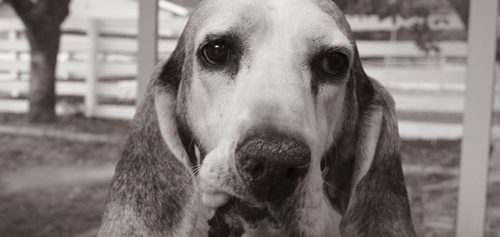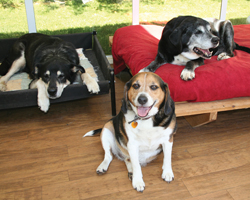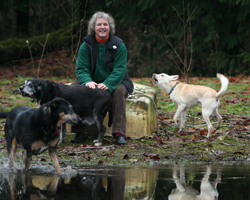

SAINTS Dog Hospice
“The average dog has one request to all humankind. Love me.” -Helen Exley
Michael had spent his entire life at the end of a chain. Now 16, the Spaniel-cross caught the eye of someone who felt sorry for him and took him home, but couldn’t manage his care. He had a massive tumour on his back-end; was totally crippled with arthritis; had end-stage cardiac disease and a grade 6 heart murmur. What Michael really needed was a loving place to die—a hospice. He found one at SAINTS.
SAINTS (Senior Animals In Need Today Society) is a registered non-profit group formally established in 2004 (though it existed in some form earlier) to provide compassionate and dignified care to senior and special-needs animals unable to find homes through the regular shelter system. The hospice was a natural progression of this concept.
It’s where Michael is now happily living out his days.
“He lives in the kitchen,” says Carol Hine, director of the society. “He’s the resident troll. He nags all the other animals constantly and is the biggest love muffin. He nuzzles you as he walks like a sideways crab. He’s happy. It’s the first time he’s been special and loved.”
Located in the hills of Mission in British Columbia, SAINTS is home to 20 dogs (and just as many cats and assorted farm animals), eight of which are palliative.

Hine’s goal is to provide the dogs with the highest quality of life. This means ample food and water, a comfortable, warm place to sleep, plenty of love and attention and, on the medical side, pain medications, treatment or surgery to control symptoms and, if the time comes that nothing can relieve the suffering, euthanasia on site.
“If we have to go to narcotics or higher-end drugs, we will do that,” says Hine. “It’s a quality of life issue. We don’t see our job to extend their lives but that whatever time they have left is of value to them and they enjoy it. We use meds to control the symptoms of disease but we don’t use expensive diagnostics like MRI as it stresses them out and we already know they are terminal.”
The hospice and shelter are in a converted home nestled into three acres of fields, streams, and barns. The property was purchased by Hine from her own resources and she works two jobs as a registered nurse to pay the wages of the two paid part-time staff. Twelve volunteers provide care, cleaning, and compassion, and donations pay for food and veterinary services.
“It’s a home environment,” says Hine, who lives there with the animals. “There are no cages. There are two gas-fired fireplaces; a red leather couch and Karunda dog beds that are low and easy for arthritic dogs to get up on. The TV plays all day long so they feel at home and there are lots of windows so it’s very bright.”
The dogs come to SAINTS a variety of ways. Some come through the pound and shelters, including the SPCA. A lot of dogs come from elderly owners who have died or gone into care and cannot keep a pet. Often, a pedigreed dog is referred from a purebred rescue group.
Hine acknowledges that these old and sick dogs are, by and large, unadoptable, so the ones at shelters are likely doomed to die there. And even though shelter staffs are good, Hine couldn’t bear the idea of these old timers spending their last days in wire cages, running on cement floors. It is a horrible place to die, Hine says.
The dogs can have any number of problems. One of the saddest realities is that the number one reason for dogs arriving at the front door of SAINTS is incontinence. They still have the ability to experience a good quality of life, but their owners cannot deal with the uncontrolled urination. Many dogs are also blind and deaf, some are crippled, some are sick and some, says Hine, are happily demented, which isn’t a big problem when they are in a safe environment.
Like Jack, for instance. The ancient little female Terrier-cross was going totally insane in a shelter kennel, throwing herself against the wall in her dementia.
“We put her on a bed. She rolled, groaned, and moaned, then went from utter terror to happy dementia,” says Hine. Jack has a mammary tumour but surgical removal was cancelled when she crashed during pre-med work.
“The tumour is spreading. She’s on pain medication but is still comfortable. You have to be careful how you pick her up, but she is happy playing. We call her the mechanical dog. She’s just a joy. Once narcotics won’t control her pain, we will put her down.”
On any given day, Hine is awake before seven to take all the dogs out for a morning bathroom break. She and her volunteers clean up the accidents from the night before, washing all bedding, bleaching floors, changing water. It is, says Hine, about four hours of hard work.

“Depending on the number of volunteers here on any given day, dogs get brushed. People come up and ask, ‘do you need something fixed?’ and wrap their arms around some dogs because it just feels good,” says Hine. “When someone scoops the yard, they throw the ball. We work in attention as we do the work.”
Bill likes this kind of attention. And, says Hine, everyone loves Bill. The 17-year-old Lab came to SAINTS not as a palliative dog but just as an older one, at ten. His mouth cancer was discovered by accident when an abscessed tooth was being removed. Even though he is now on pain medication, Hine says he still runs twice a day, just flying through the field.
“He doesn’t know he is sick and dying,” says Hine. “Someone could have had him for seven years.”
And that is Hine’s greatest heartbreak. Sure, she has to watch so many dogs take their last breaths, and sure, she struggles with an increasing need for donations and additional volunteers to hold and hug the dogs. But, more than anything, she says, she wants people to not be afraid to adopt palliative or senior dogs.
“After a lifetime of service to mankind,” says Hine, “they don’t deserve to end their lives in a cage. While it takes a lot for a human to invest their heart and soul in something that can be gone in a few months, it is such a gift of gratitude and loyalty. I’d like to see the day when I can’t find a senior dog to rescue if my life depended on it.”
To learn more about SAINTS, find out how you can help, or take a virtual tour of the shelter, visit saintsrescue.ca.
Corey Van’t Haaff owns Cohiba Communications and writes regularly about business, medicine, law, marketing, consumer issues, and her favourite topic, dogs. Her work is also broadcast occasionally on CBC Radio. When not working, she spends an inordinate amount of time with her five pooches: Esmerelda, Tallula, Clara, Matilda, and Stella, who came from SAINTS Rescue. For an old poodle, Stella has plenty of life and fun in her, and keeps everyone in line. Stella is proof that a senior dog can add years of happiness to an adoptive home. Corey is forever grateful for SAINTS. Corey can be reached at corey@cohibacommunications.com.
Join the newsletter and never miss out on dog content again!
"*" indicates required fields
By clicking the arrow, you agree to our web Terms of Use and Privacy & Cookie Policy. Easy unsubscribe links are provided in every email.